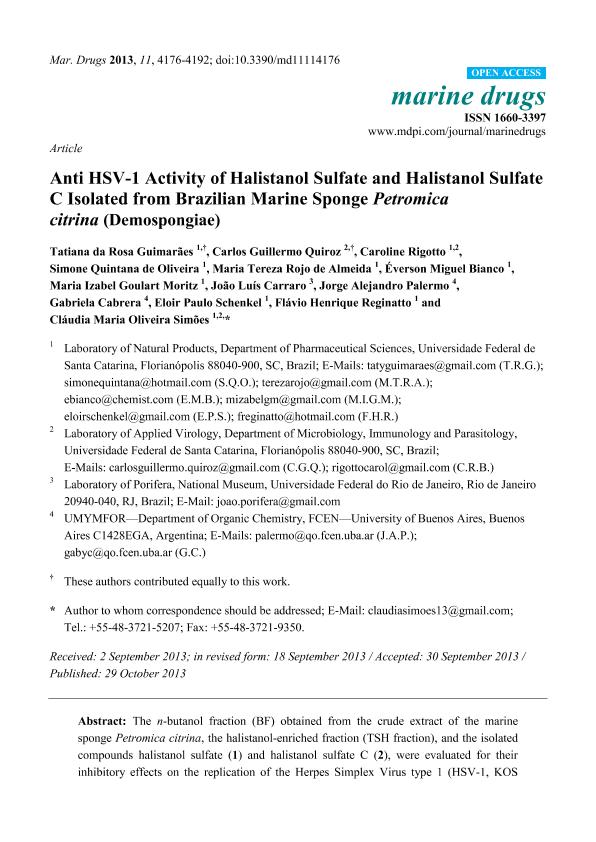Artículo
Anti HSV-1 activity of halistanol sulfate and halistanol sulfate C isolated from Brazilian marine sponge Petromica citrina (Demospongiae)
Guimarães, Tatiana Da Rosa; Quiroz, Carlos Guillermo; Rigotto, Caroline; De Oliveira, Simone Quintana; Rojo de Almeida, Maria Tereza; Bianco, Éverson Miguel; Moritz, Maria Izabel Goulart; Carraro, João Luís; Palermo, Jorge Alejandro ; Cabrera, Gabriela Myriam
; Cabrera, Gabriela Myriam ; Schenkel, Eloir Paulo; Reginatto, Flávio Henrique; Oliveira Simões, Cláudia Maria
; Schenkel, Eloir Paulo; Reginatto, Flávio Henrique; Oliveira Simões, Cláudia Maria
 ; Cabrera, Gabriela Myriam
; Cabrera, Gabriela Myriam ; Schenkel, Eloir Paulo; Reginatto, Flávio Henrique; Oliveira Simões, Cláudia Maria
; Schenkel, Eloir Paulo; Reginatto, Flávio Henrique; Oliveira Simões, Cláudia Maria
Fecha de publicación:
11/2013
Editorial:
Molecular Diversity Preservation International
Revista:
Marine Drugs
ISSN:
1660-3397
Idioma:
Inglés
Tipo de recurso:
Artículo publicado
Clasificación temática:
Resumen
The n-butanol fraction (BF) obtained from the crude extract of the marine sponge Petromica citrina, the halistanol-enriched fraction (TSH fraction), and the isolated compounds halistanol sulfate (1) and halistanol sulfate C (2), were evaluated for their inhibitory effects on the replication of the Herpes Simplex Virus type 1 (HSV-1, KOS strain) by the viral plaque number reduction assay. The TSH fraction was the most effective against HSV-1 replication (SI = 15.33), whereas compounds 1 (SI = 2.46) and 2 (SI = 1.95) were less active. The most active fraction and these compounds were also assayed to determine the viral multiplication step(s) upon which they act as well as their potential synergistic effects. The anti-HSV-1 activity detected was mediated by the inhibition of virus attachment and by the penetration into Vero cells, the virucidal effect on virus particles, and by the impairment in levels of ICP27 and gD proteins of HSV-1. In summary, these results suggest that the anti-HSV-1 activity of TSH fraction detected is possibly related to the synergic effects of compounds 1 and 2.
Palabras clave:
ANTIVIRAL ACTIVITY
,
HSV-1
,
MARINE SPONGE
,
PETROMICA CITRINA
,
SULFATE STEROLS
Archivos asociados
Licencia
Identificadores
Colecciones
Articulos(UMYMFOR)
Articulos de UNID.MICROANAL.Y MET.FISICOS EN QUIM.ORG.(I)
Articulos de UNID.MICROANAL.Y MET.FISICOS EN QUIM.ORG.(I)
Citación
Guimarães, Tatiana Da Rosa; Quiroz, Carlos Guillermo; Rigotto, Caroline; De Oliveira, Simone Quintana; Rojo de Almeida, Maria Tereza; et al.; Anti HSV-1 activity of halistanol sulfate and halistanol sulfate C isolated from Brazilian marine sponge Petromica citrina (Demospongiae); Molecular Diversity Preservation International; Marine Drugs; 11; 11; 11-2013; 4176-4192
Compartir
Altmétricas



